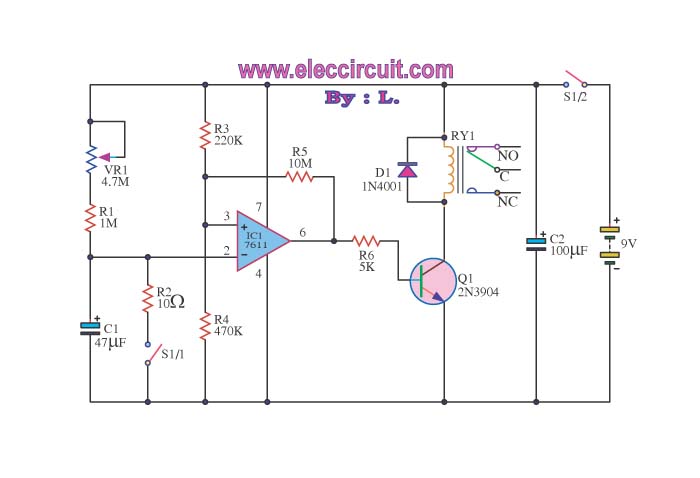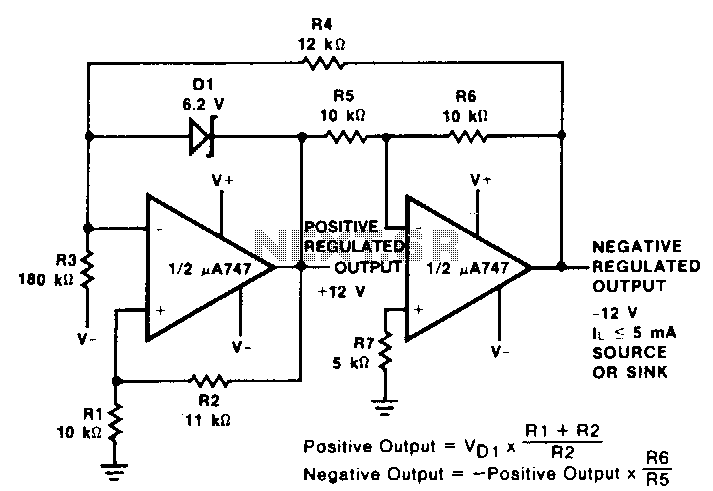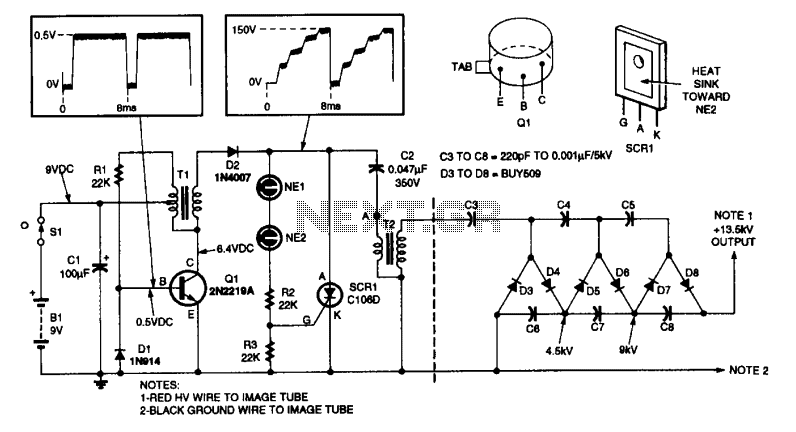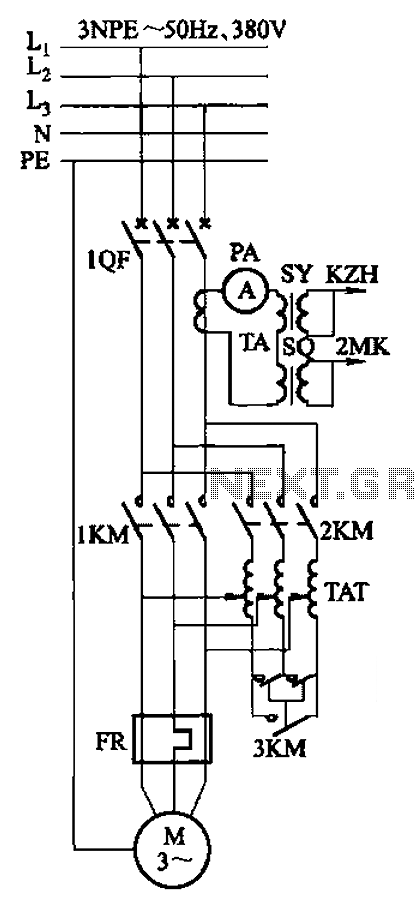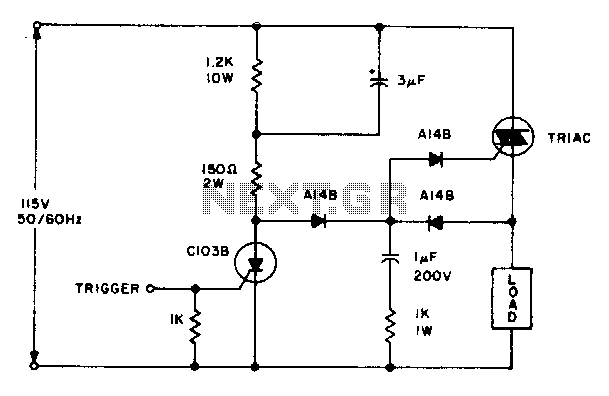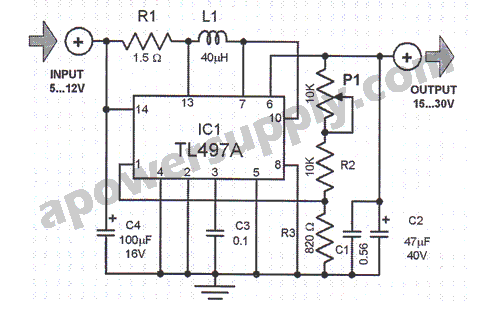
switch mode voltage regulator with 85 efficiency
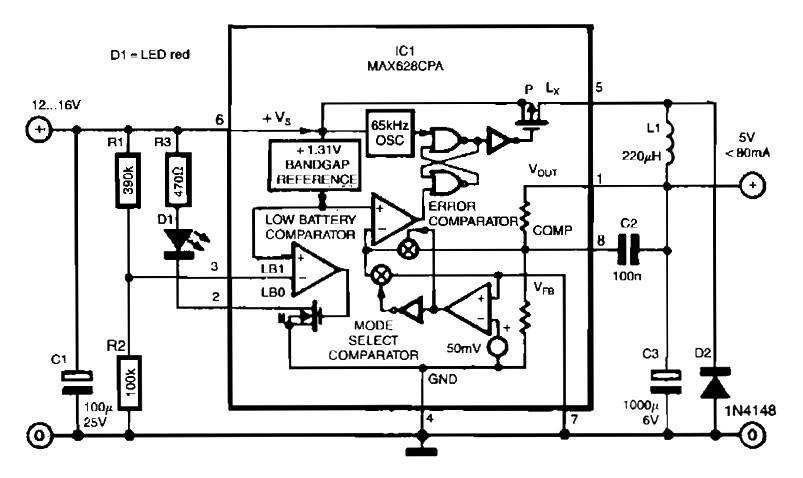
The circuit is straightforward due to the use of the MAX638CPA 5V CMOS Step Down Adjustable Switching Regulator IC. This IC converts an input voltage of 12 to 16 VDC into a stable 5VDC output. The circuit requires only nine additional external components to be fully operational. The schematic diagram is derived from a switch mode voltage regulator with an efficiency of 85%. Further details regarding the power supply and its related circuit diagram can be found on the referenced page.
The MAX638CPA is a highly efficient switching regulator designed to step down higher DC voltages to a lower, regulated output voltage. In this configuration, the input voltage range of 12 to 16 volts is ideal for various applications, as it allows for flexibility in power supply options while ensuring that the output remains stable at 5 volts.
The nine external components typically include input and output capacitors, an inductor, and feedback resistors that set the output voltage. The input capacitor is crucial for stabilizing the input voltage and reducing ripple, while the output capacitor smooths the output voltage and minimizes voltage fluctuations. The inductor is a key component in the switching regulator, storing energy during the on phase and releasing it during the off phase, which helps maintain a continuous output current.
The feedback resistors are essential for adjusting the output voltage to the desired level, allowing for fine-tuning of the output to meet specific load requirements. The efficiency of 85% indicates that the circuit effectively converts the input power to output power with minimal losses, making it suitable for battery-powered applications where energy conservation is critical.
This circuit can be utilized in various electronic devices that require a reliable 5V power supply, such as microcontrollers, sensors, and communication devices. The simplicity of the design, combined with the efficiency of the MAX638CPA, makes it an excellent choice for engineers looking to implement a compact and reliable voltage regulation solution.The circuit is quite simple thanks to the use of MAX638CPA 5V CMOS Step Down Adjustable Switching Regulator IC. With this IC input voltage of 12 to 16 Vdc converted into direct voltage 5VDC. You can see here is only using 9 additional external components to complete the circuit. The schematic diagram come from circuit: Switch Mode Voltage Regulato r with 85% efficiency power supply. Go to that page to read the explanation about above power supply related circuit diagram. 🔗 External reference
The MAX638CPA is a highly efficient switching regulator designed to step down higher DC voltages to a lower, regulated output voltage. In this configuration, the input voltage range of 12 to 16 volts is ideal for various applications, as it allows for flexibility in power supply options while ensuring that the output remains stable at 5 volts.
The nine external components typically include input and output capacitors, an inductor, and feedback resistors that set the output voltage. The input capacitor is crucial for stabilizing the input voltage and reducing ripple, while the output capacitor smooths the output voltage and minimizes voltage fluctuations. The inductor is a key component in the switching regulator, storing energy during the on phase and releasing it during the off phase, which helps maintain a continuous output current.
The feedback resistors are essential for adjusting the output voltage to the desired level, allowing for fine-tuning of the output to meet specific load requirements. The efficiency of 85% indicates that the circuit effectively converts the input power to output power with minimal losses, making it suitable for battery-powered applications where energy conservation is critical.
This circuit can be utilized in various electronic devices that require a reliable 5V power supply, such as microcontrollers, sensors, and communication devices. The simplicity of the design, combined with the efficiency of the MAX638CPA, makes it an excellent choice for engineers looking to implement a compact and reliable voltage regulation solution.The circuit is quite simple thanks to the use of MAX638CPA 5V CMOS Step Down Adjustable Switching Regulator IC. With this IC input voltage of 12 to 16 Vdc converted into direct voltage 5VDC. You can see here is only using 9 additional external components to complete the circuit. The schematic diagram come from circuit: Switch Mode Voltage Regulato r with 85% efficiency power supply. Go to that page to read the explanation about above power supply related circuit diagram. 🔗 External reference
